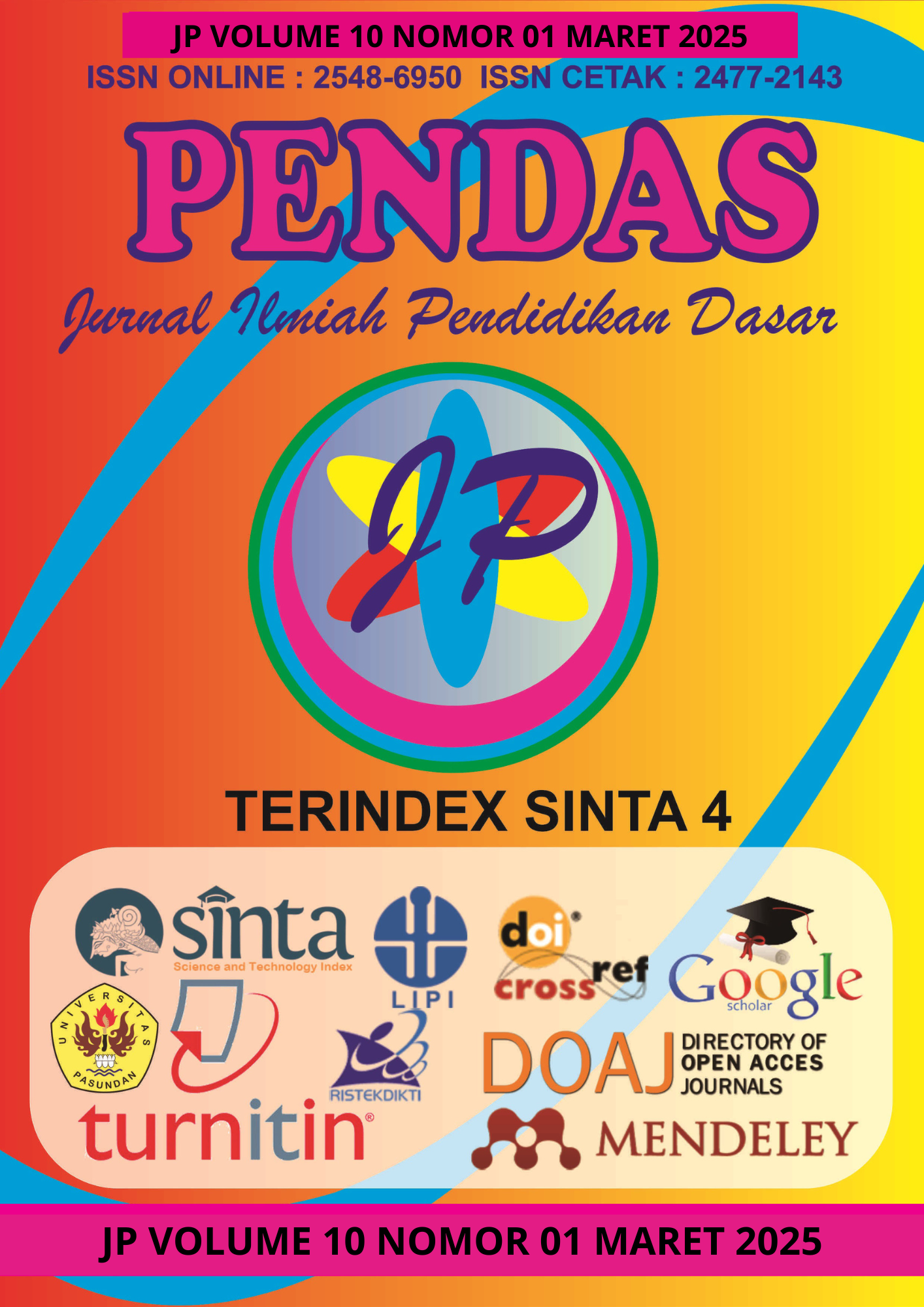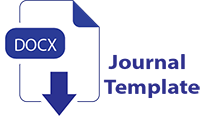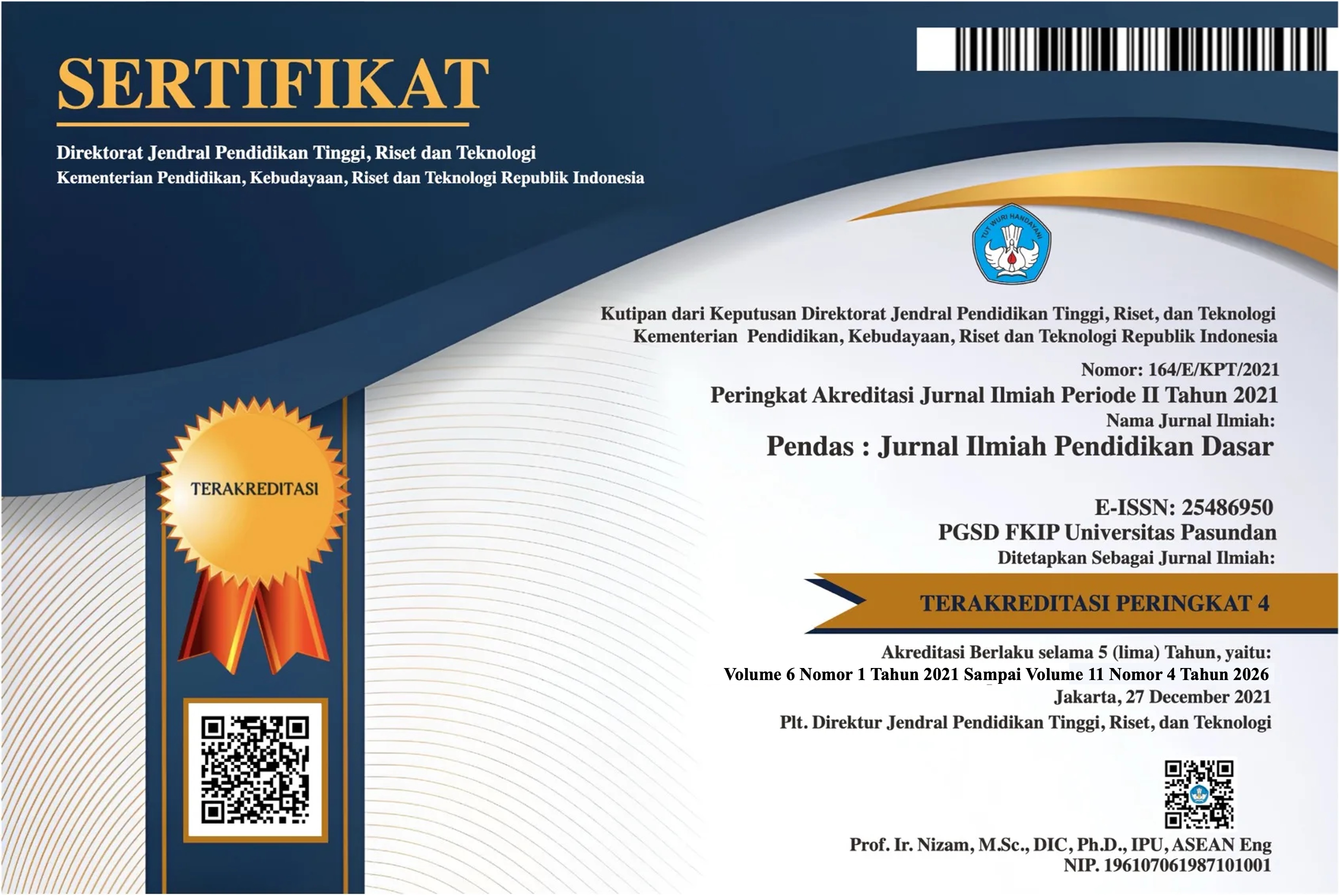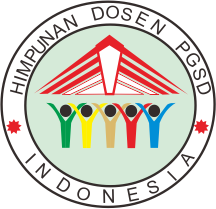HUBUNGAN SELF-REGULATED LEARNING DAN BERFIKIR KRITIS DENGAN KEMAMPUAN LITERASI DIGITAL DAN LITERASI NUMERASI SEKOLAH DASAR TAHUN PELAJARAN 2024-2025
DOI:
https://doi.org/10.23969/jp.v10i01.23889Abstract
This study aims to analyze the relationship between Self-Regulated Learning and critical thinking on digital literacy and numeracy literacy of elementary school students. The subjects of the study were 100 6th grade students from five schools in Bandung Kulon District. The canonical correlation method was used with instruments in the form of questionnaires for Self-Regulated Learning and digital literacy, as well as tests for critical thinking skills and numeracy literacy. Assumption tests include normality, linearity, non-multicollinearity, and homogeneity of variance-covariance. The results show a canonical correlation significance value of 0.000 (<0.05), which indicates a significant relationship between the variables. The first and second canonical functions are significant with p values of 0.000 and 0.02, respectively. The canonical coefficient and loading indicate that critical thinking has a dominant influence in improving numeracy literacy, while Self-Regulated Learning plays an important role in strengthening digital and numeracy literacy. This study confirms the importance of Self-Regulated Learning and critical thinking in improving student literacy and provides insight into efforts to improve literacy in the digital eraDownloads
References
Akpur, U. (2020). Critical, Reflective, Creative Thinking and Their Reflections on Academic Achievement. Thinking Skills and Creativity, 37. https://doi.org/10.1016/j.tsc.2020.100683
Bateman, J. A. (2021). What are digital media? Discourse, Context and Media, 41. https://doi.org/10.1016/j.dcm.2021.100502
Bandura, A. (1997). Self-efficacy: The exercise of control. New York, NY: W. H. Freeman.
Borodzhieva, A. N. (2022). Project-Based Learning for Teaching the Knapsack Problem in the Course “Telecommunication Security.” In 2022 21st International Symposium INFOTEH-JAHORINA, INFOTEH 2022 - Proceedings. https://doi.org/10.1109/INFOTEH53737.2022.9751273
Braak, D. ten. (2022). Why do early mathematics skills predict later mathematics and reading achievement? The role of executive function. Journal of Experimental Child Psychology, 214.
https://doi.org/10.1016/j.jecp.2021.105306
Crick, T. (2022). Rethinking Digital Competencies in the New Curriculum for Wales. In Annual Conference on Innovation and Technology in Computer Science Education, ITiCSE (Vol. 2, p. 635). https://doi.org/10.1145/3502717.3532145
Dekker, T. J. (2020). Teaching critical thinking through engagement with multiplicity. Thinking Skills and Creativity, 37.
https://doi.org/10.1016/j.tsc.2020.100701
Díaz, M. J. S. (2021). Emergency remote education, family support and the digital divide in the context of the covid-19 lockdown. International Journal of Environmental Research and Public Health, 18(15). https://doi.org/10.3390/ijerph18157956
Gal, I. (2020). Numeracy, adult education, and vulnerable adults: a critical view of a neglected field. ZDM - Mathematics Education, 52(3), 377–394. https://doi.org/10.1007/s11858-020-01155-9
Garavaglia, A. (2022). Integration of LifeComp and DigComp 2.2 as a Theoretical Framework for Media Education. In Communications in Computer and Information Science (Vol. 1649, pp. 59–70). https://doi.org/10.1007/978-3- 031-20777-8_5
Garcia-Esteban, S. (2020). Skills in European higher education mobility programmes: outlining a conceptual framework. Higher Education, Skills and Work-Based Learning, 10(3), 519–539. https://doi.org/10.1108/HESWBL-09-
2019-0111
Glister, P. (1997). Digital literacy. Wiley Computer Pub.
Harris, D. (2022). Radical rubrics: implementing the critical and creative thinking general capability through an ecological approach. Australian Educational Researcher. https://doi.org/10.1007/s13384-022-00521-8
Indah, R. N. (2022). The Research Competence, Critical Thinking Skills and Digital Literacy of Indonesian EFL Students. Journal of Language Teaching and Research, 13(2), 315–324. https://doi.org/10.17507/jltr.1302.11
Indefenso, E. E. (2020). Numeracy level, mathematics problem skills, and financial literacy. Universal Journal of Educational Research, 8(10), 4393–4399. https://doi.org/10.13189/ujer.2020.081005
Jiang, L. (2022). Incorporating digital multimodal composing through collaborative action research: challenges and coping strategies. Technology, Pedagogy and Education,31(1), 45–61. https://doi.org/10.1080/1475939X.2021.197853477
Krämer, S. (2022). Should we really ‘hermeneutise’ the Digital Humanities? A plea for the epistemic productivity of a ‘cultural technique of flattening’ in the Humanities. Journal of Cultural Analytics, 7(4). https://doi.org/10.22148/001c.55592
Leeuw, J. A. De. (2020). Identification of factors influencing the adoption of health information technology by nurses who are digitally lagging: In-depth interview study. Journal of Medical Internet Research, 22(8). https://doi.org/10.2196/15630
Mirra, N. (2021). In Search of the Meaning and Purpose of 21st-Century Literacy Learning: A Critical Review of Research and Practice. Reading Research Quarterly, 56(3), 463–496. https://doi.org/10.1002/rrq.313
Novitasari, M. (2020). Habituation of digital literacy and critical thinking in mathematics in elementary school. International Journal of Scientific and Technology Research, 9(3), 3395–3399. https://api.elsevier.com/content/abstract/scopus_id/85082705943
Pangrazio, L. (2020). What is digital literacy? A comparative review of publications across three language contexts. E-Learning and Digital Media, 17(6), 442–
459. https://doi.org/10.1177/2042753020946291
Perez, M. E. D.-M. (2022). Self-regulated learning of early childhood education students making oral storytelling with an app. Texto Livre, 15. https://doi.org/10.35699/1983-3652.2022.37844
Piaget, J. (1952). The origins of intelligence in children. New York, NY: International Universities Press.
Quigley, K. S. (2021). Functions of Interoception: From Energy Regulation to Experience of the Self. In Trends in Neurosciences (Vol. 44, Issue 1, pp. 29– 38). https://doi.org/10.1016/j.tins.2020.09.008
Robson, D. A. (2020). Self-Regulation in Childhood as a Predictor of Future Outcomes: A Meta-Analytic Review. Psychological Bulletin, 146(4), 324–
354. https://doi.org/10.1037/bul0000227
Sangur, K. (2023). PjBL-HOTS: Integration of Learning in Improving Critical Thinking and Digital Literacy of Biology Education Students. In AIP Conference Proceedings (Vol. 2642). https://doi.org/10.1063/5.0110304
Seider, S. (2020). The Development of Critical Consciousness and its Relation to Academic Achievement in Adolescents of Color. Child Development, 91(2). https://doi.org/10.1111/cdev.13262
Setiyani. (2022). Mathematical Reflective Thinking Process of Prospective Elementary Teachers Review from the Disposition in Numerical Literacy Problems. In International Journal of Educational Methodology (Vol. 8, Issue 3, pp. 405–420). https://doi.org/10.12973/IJEM.8.3.405
Sikko, S. A. (2023). What Can We Learn from the Different Understandings of Mathematical Literacy? Numeracy, 16(1). https://doi.org/10.5038/1936- 4660.16.1.1410
Sugiono, S. (2021). A new concept of product design by involving emotional factors using eeg: A case study of xomputer mouse design. Acta Neuropsychologica,19(1),63–80. https://doi.org/10.5604/01.3001.0014.7021
Syefrinando, B. (2022). THE EFFECT OF DIGITAL LITERACY CAPABILITIES AND SELF-REGULATION ON THE STUDENT’S CREATIVITY IN
ONLINE PHYSICS TEACHING. Jurnal Pendidikan IPA Indonesia, 11(3), 489–499. https://doi.org/10.15294/jpii.v11i3.31811
Testers, L. (2020). Taking Affective Learning in Digital Education One Step Further: Trainees’ Affective Characteristics Predicting Multicontextual Pre- training Transfer Intention. Frontiers in Psychology, 11. https://doi.org/10.3389/fpsyg.2020.02189
Wang, D. (2020). Self-Learning Optimal Regulation for Discrete-Time Nonlinear Systems under Event-Driven Formulation. IEEE Transactions on Automatic Control, 65(3), 1272–1279. https://doi.org/10.1109/TAC.2019.2926167
Yondler, Y. (2023). What is the degree of teacher centrality in optimal teaching of digital literacy in a technology-enhanced environment? Typology of teacher prototypes. Journal of Research on Technology in Education, 55(2), 230–251. https://doi.org/10.1080/15391523.2021.1950084
Zimmerman, B. J. (2023). Dimensions of Academic Self-Regulation: A Conceptual framework for Education. In Self-Regulation of Learning and Performance Issues and Educational Applications (pp. 3–22). https://doi.org/10.4324/9780203763353-1
Creswell, J. W. (2014). Research Design: Qualitative, Quantitative, and Mixed Methods Approaches (4th ed.). SAGE Publications.
Hair, J. F., Black, W. C., Babin, B. J., Anderson, R. E., & Tatham, R. L. (2010). Multivariate Data Analysis (7th ed.). Pearson.
Vygotsky, L. S. (1986). Thought and language. Cambridge, MA: MIT Press.
Downloads
Published
Issue
Section
License
Copyright (c) 2025 Pendas : Jurnal Ilmiah Pendidikan Dasar

This work is licensed under a Creative Commons Attribution 4.0 International License.



















